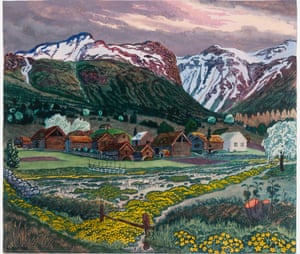Jonathan Jones - Nikolai Astrup: the lost artist of Norway
Norway’s legendary modern artist who captured his country’s
fantastically eerie landscapes is about to be celebrated. And no, it isn’t Edvard Munch. It’s Nikolai Astrup – a legend in his own land, but barely
known outside of it. In fact, the Dulwich
Picture Gallery, in London, is putting on the first significant show of
Astrup’s work outside Norway in the new year. Will it make him as famous as
Munch, his contemporary?

Marsh Marigold Night, c 1915, by Nikolai Astrup. Photograph:
Dag Fosse/Kode Art Museums of Bergen
It seems suspiciously as if the world only has room for one great Norwegian artist.
Astrup was
born in 1880 and died in 1928, while Munch was born in 1863 and died in 1944.
It is impossible to avoid comparing the two, because both are expressionists
who take the real world and transfigure it in blazing, lurid colours. They even
have a favourite theme in common: the strange light of summer evenings, when
the warmth of the far north makes everything look like a fairytale or a
hyper-lucid dream.
Astrup’s paintings of people dancing wildly around midsummer
bonfires have a lot in common with Munch’s Frieze
of Life series. But there is one big difference: Astrup is so much brighter
– not just in colour, but also in mood. Just because he is Nordic does not mean
he is noir. In fact, this artist – whose style has a rough-hewn, woodcut-like
quality (as, of course, do his woodcuts) – is not very “modern” at all. He is a
traditional landscape artist with a veneer of expressionist distortion. His
true appeal is that he captures the drama, both sublime and pastoral, of the
Norwegian landscape.
The gentleness of Astrup’s vision – his love of nature and
idyllic images of rural life – is surely what makes him so loved in Norway. But
he is now another building block to broaden knowledge about Scandinavian art
outside Scandinavia. This exhibition follows on from a fascinating
show at the National Gallery last winter of the 19th-century Norwegian
landscape painter Peder
Balke. Astrup shows that Balke’s romanticism was very much alive in
20th-century Norway.
see more picture-prints:
